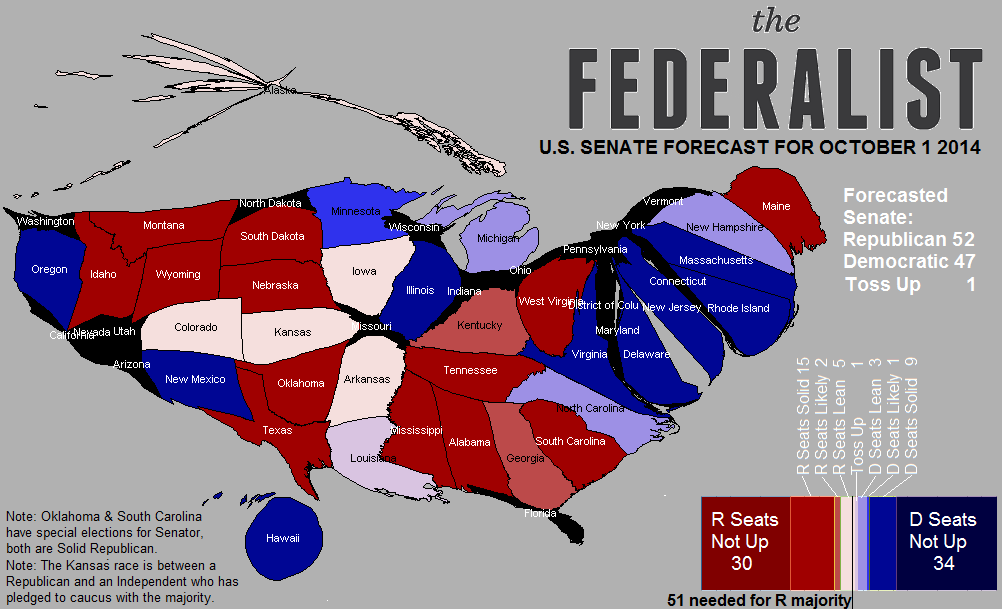
A lot has changed since we last brought you a look at November, so let’s go through those changes before we get to the forecast.
First, with just five weeks to go, we have eliminated a few categories and changed their meaning for the races.
SOLID R/D: This is a race where the Republican or Democrat is clearly favored, barring an Act of Cthulu. While certain races may have been promising at some point in the cycle for either side (Oregon, New Mexico, and Virginia for the Republicans, Mississippi for the Democrats), with less than five weeks to go, these seats aren’t budging.
LIKELY R/D: These are races that have the potential for an upset, but it has grown remote. Republicans have two in this category, Democrats one.
LEAN R/D: These are races that have broken in one direction or the other, but are still close enough where an upset is a good possibility, just not the likeliest possibility.
TOSS UP: Either because of the polling data or strange election circumstances, we don’t feel comfortable calling it either way.

Over at my new website, our current average leads for the twelve likely, lean, and toss-up races, as of September 30, are:
Louisiana: Cassidy (R) by 4.4 points
Arkansas: Cotton (R) by 2.2 points
Alaska: Sullivan (R) by 2.6 points
Colorado: Gardner (R) by 3.2 points
Iowa: Ernst (R) by 2.8 points
Kentucky: McConnell (R) by 5.8 points
Georgia: Perdue (R) by 3.4 points
Kansas: Orman (I) by 5.5 points
Michigan: Peters (D) by 3.8 points
North Carolina: Hagan (D) by 3.6 points
New Hampshire: Shaheen (D) by 4.8 points
Minnesota: Franken (D) by 9.5 points
The polling average carries a lot of weight when it comes to forecasting each race, with historical results, campaign spending, and the national mood also factored in. Every race within five points is considered a leaner, with a few exceptions, and I’ll explain them.
Georgia
Michelle Nunn polled strongly at the onset of this cycle, but has trailed David Perdue narrowly yet consistently since the runoff primary, leading in a poll here or there but still stuck in the lower forties. That last part is critical here: if Nunn were polling at the same margin but in the upper forties, the race would indeed be a tossup. If no one crosses 50 percent on election day, a runoff election will occur in January, and that’s where Nunn’s chances completely crater. While it is true that the runoff turnout in 2009 for the 2008 Georgia Senate race was closer to a midterm, that was also in a cycle of huge political engagement, much stronger than what we are seeing this year. There will be a sizable dropoff in votes from November to January, and Nunn will lose more than Perdue. With Perdue maintaining a small but consistent lead, and with Nunn nowhere near the level she needs to avoid a runoff, it’s now likely Republican.
Kansas
Greg Orman has led the embattled Pat Roberts in both polls released since the Democrat dropped out here, and has been positioning himself as an Independent who may vote with whichever party wins the majority. Make no mistake about it: Democrats are excited at the prospect of a Senator Orman, who has been one of them officially until recently. His problem is that his coalition includes many disgruntled Republicans, many of them conservatives, who would still want him to cast with their party. If he starts to lean in one direction or the other, his bloc breaks apart and Roberts wins. If he stays true to his word and Republicans gain the majority, he caucuses with them so the seat doesn’t change in that scenario either. Kansas hasn’t voted for a Democratic senator in decades, and while Roberts is the most vulnerable he has ever been, the nature of the state and the perilous wire Orman must walk leaves this race as lean Republican.
There is also one state where the Republican holds a wider margin than in the others, but we still can’t call the seat either way.
Louisiana
Rep. Bill Cassidy has seen a nice bump in his polling versus Sen. Mary Landrieu. We use the runoff polling from each firm, as it looks very unlikely Cassidy or Landrieu will hit 50 percent in the jungle primary, but both will certainly make the top two, and it gives us a better picture of how much trouble Landrieu really is in.
Or is there something about Mary that voters can’t resist? Landrieu is two for two in Senate runoffs, winning back-to-back this way in 1996 and 2002. While the demographics of the state have changed since Katrina, it would be foolish with such a record of tough wins to say she’s a goner. Barring polling showing a Cassidy win in the primary, so a toss-up it is.
Overall, the picture is bright for Republicans, with a net seven-seat pickup (Montana, South Dakota, and West Virginia are now solid gains). However, the canvas just been primed. Voters are beginning to sketch in the details through early voting, and in one state, it is reinforcing the frustration of many Republicans with a particularly disappointing race.
North Carolina
Sen. Kay Hagan’s thin lead suggests a close race, much like what we saw in Alaska, Colorado, and Iowa, but unlike her colleagues there, she has managed to stay ahead. After a dramatic drop over the course of numerous surveys through 2013 into early 2014, she has recovered a small but consistent lead over Thom Tillis, who is watching his disapproval ratings climb whilst being pummeled by Hagan’s ads. He can’t blame his current situation on being out-banked: Mark Udall and Bruce Braley have had more cash at their disposal, and both trail their Republican opponents. Tillis can’t blame disunity within his own party, either: Mitch McConnell is viewed with distrust by a lot of conservatives, yet he is now the clear favorite in Kentucky. We feel his inability to shift the narrative back to Washington and away from North Carolina, where he has been under a magnifying glass with the rest of the legislature, has been his biggest problem. The candidates that have effectively made their opponents into creatures of DC or co-signers on a weak presidential administration have found small leads (Joni Ernst, Cory Gardner) or narrowed the pathway against a popular incumbent (Scott Brown). Those that have botched whatever footing they did have simply trail.
Republicans have much to be excited about, but must keep in mind the closeness of these contests: the difference between a Senate majority and minority comes down to just a few points in almost a dozen states, and there is still enough time for a gaffe, misfire, or complacency to make those small leads vanish. They are in the best position they have been all year to hold both houses of Congress. Will they blow it?









